Pat Cleveland: the model who partied with Warhol, lived with Lagerfeld – and took on Vogue
‘I didn’t see anybody that looked like me, or was like me’ ... Pat Cleveland at home in New Jersey last month. Photograph: Paul Van Ravenstein
She received death threats as a young model, but that didn’t stop her. She refused Muhammad Ali’s proposal, inspired Dalí and set up her own agency – then became an artist
by
Ellen E Jones
Thu 13 Aug 2020 06.00 BST
In the late 60s, Pat Cleveland was one of the most popular models in New York, working with the best-known photographers:
Irving Penn,
Richard Avedon and Hiro. Yet she could not get on the cover of Vogue. The photographers “were all very upset”, she says, “because they’d shoot covers of me and sometimes the editors said: ‘Wow! This is the cover!’ Then they’d replace me with a caucasian girl. I just got fed up.”
She made a vow. “Why am I going to waste my time” in the US, she wondered, “when they don’t care about people of colour?” In 1971, she moved to France, promising not to return to the US until a black model was on the cover of US Vogue.
Paris was a promised land. She slept on the floor of one of Karl Lagerfeld’s apartments with fellow models Corey Tippin and
Donna Jordan and the Vogue illustrators Antonio Lopez and Juan Ramos. She remembers the young(ish) Lagerfeld fondly: “He was like a muscle man at the time. He had this gym in his house, all mirrors and low black lighting and calla lilies.” The illustrators would sketch the models until midnight, when everyone got dressed up and went out to the nightclubs – Le Palace and Nuage.
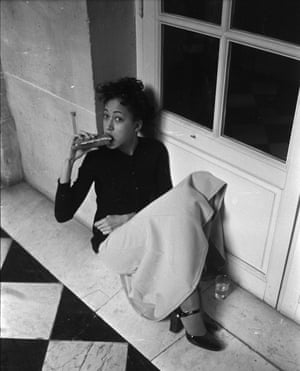 FacebookTwitterPinterest
FacebookTwitterPinterest
‘Every time we went out, we thought we were the Folies-Bergère’ ... Cleveland eating a sandwich at the Battle of Versailles in 1973. Photograph: Fairchild Archive/Penske Media/Rex/Shutterstock
In 1973, American and French designers were asked to compete in a legendary fashion show, the Battle of Versailles, held at the historic palace. French designers including Yves Saint Laurent, Christian Dior and Hubert de Givenchy competed against Halston, Bill Blass and Anne Klein. The Americans showed their designs on a group of models that included 11 African Americans – which was unprecedented at the time – and unexpectedly emerged triumphant. “Black was popular,” says Cleveland. The mood among the models was comradely. “There were no catfights. It was like: ‘Hey, let’s get it!’ We had our routines – every time we went out, we thought we were the Folies-Bergère.”
The following year, the black model Beverly Johnson appeared on the cover of US Vogue. Cleveland was as good as her word. She returned to New York and began spending her nights at
Studio 54.
In the 60s and 70s, she says, you had a choice. “It was like: are you gonna hang out with the hippies, who are all lying around in beanbag chairs with torn jeans and fuzzy hair? Or are you gonna comb your hair and go out at night and have mimosas and
steak au poivre and dance with the Supremes?”
Mick Jagger was “one of the gang”. They dated, but rock star boyfriends were no big deal: “There was nobody else around. It’s not like you could go out shopping in a regular grocery store. You always had to shop at the specialty shop.”
One summer in Florida,
Muhammad Ali proposed to her. “He was just a big, fluffy, teddy bear guy; shy and southern with nice, soft hair. He had this convertible Cadillac with two bodyguards sat in the front and he’d take me out driving. He’d always say stuff like: ‘OK, watch this!’ then drive to a poor area where all the people would recognise him, like: ‘Muhammad! Muhammad!’ He’d stand up and say: ‘Yeah, it’s me! You put your money on me and I’ll win for you.’” He would say this in a rhythm, like “hip-hop rhyming”, she says. “I think he started that.”
Ultimately, however, she and Ali were not simpatico. “One morning, he saw me in my bikini, jumped at me with a towel, wrapped it around me and says: ‘Well, if you’re gonna be my wife, you cannot wear that.’ I thought ‘Oooh, this is too strange for me!’”
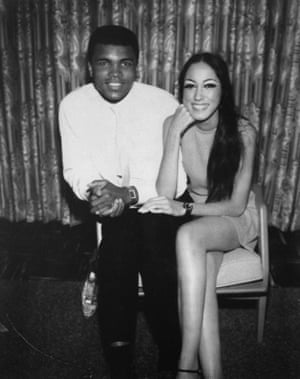 FacebookTwitterPinterest
FacebookTwitterPinterest
‘He was just a big, fluffy, teddy bear guy’ ... Cleveland with Muhammad Ali in 1966. Photograph: Lady Bird Cleveland
Andy Warhol was also a friend and she was a regular for afternoon tea at Salvador Dalí’s. “I’d be sitting there posing like a little dog and he would never do a drawing. He’d just walk around the table looking at me.” Surely being a muse got tedious? “Oh no! I’m not the muse; they were my muses. I was watching and studying them.”
Cleveland had been painting since childhood and was educated at the High School of Art and Design in Manhattan (alumni include Calvin Klein, Marc Jacobs and her lifelong friend Lopez). Most of the people she met were too busy looking at her to realise she was looking right back.
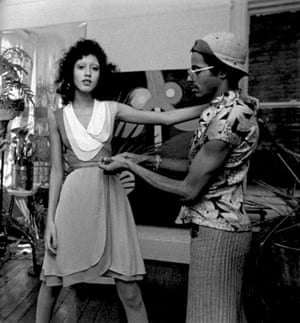 FacebookTwitterPinterest
FacebookTwitterPinterest
‘Designers and artists are put here to make the world beautiful’ ... Cleveland at a fitting with the designer Stephen Burrows. Photograph: Pierre Schermann/Condé Nast Archive/Corbis
Cleveland still models – she walked for the designers Nicole Miller and Chiara Boni at last autumn’s New York fashion week – although “danced” is a better way to describe it. “There’s this open space in front of you, and when the spotlight is on you feel like you’re flying to the sun. You feel the energy of the people and you can hear their hearts beating. Then you think to yourself: ‘Oh, these are my people! I gotta make ’em happy today!’”
When we speak over video chat, she is in her New Jersey studio, surrounded by brushes and half-finished works, mostly colourful collages, some incorporating her modelling shots. At 70, she seems unchanged. She still has the effervescence that has ensured invitations to every party worth going to for the past 50 years.
It is easy to imagine her as a kid, sitting at the knee of her mother. Lady Bird Cleveland worked as an artist at the tail end of the Harlem Renaissance, specialising in black history subjects, raising her only child with the support of friends including the photographer Carl Van Vechten and the opera singer Marian Anderson. “Sometimes I’d drink the water from the watercolours,” says Cleveland; her mother would say: “Well, if you don’t drink the paint, you’ll never be an artist.” Our call is suddenly interrupted. “Can you hear that?” she says. “The peacocks!” She and her husband keep them as pets. It seems apt.
Cleveland feels an affinity with designers because, when she started out, she was one. As a tall, slim 15-year-old, she could not find anything to fit, so she began making her own clothes. She was invited to sell her mini-skirts at a boutique next to the Manhattan nightclub Cheetah. “On the weekend, I’d drop off the clothes, go dance, come back, pick up my cash and go home,” she says.
Her outfits caught the eye of a Vogue employee on a New York subway platform in 1966 and she featured in the magazine as an up-and-coming designer. When she began modelling, she says, there were not 1,000 people “trying to get your one spot. It wasn’t fame. It was more like you wanted to work with the designer, y’know?”
That year, Cleveland was invited to take part in the touring Ebony fashion fair, arranged by Eunice Johnson, the pioneering black businesswoman and co-founder of Ebony magazine. Black people were excluded from fashion and some clothing shops at the time, so the show provided access and inspiration. Johnson “was the wealthiest woman of colour in the United States”, says Cleveland. “She would go to the shows in Europe and buy the entire collection, then show these clothes in selected [US] cities, where the cream of the black society was. She put Yves Saint Laurent on the map. She had Cardin, Dior, Givenchy, Chanel. She had everybody.”
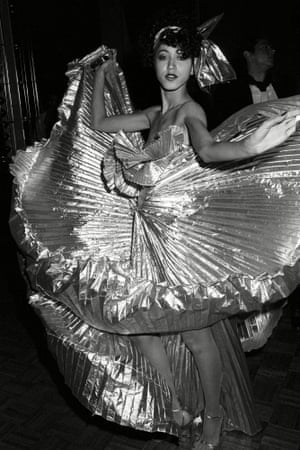 FacebookTwitterPinterest
FacebookTwitterPinterest
‘Black was popular’ ... Cleveland at a Halston party at Studio 54, New York, in December 1977. Photograph: Guy Marineau/Shutterstock
Cleveland had experienced racism before, particularly when visiting her mother’s hometown in Georgia. “I had cousins who were not as fair-skinned as me and we’d go for a walk in town and be accosted by racists throwing rocks. I was from New York, so what did I know? I just threw rocks back. I thought it was a game, but we could have been killed.”
When she toured the south with the Ebony fashion fair, the models received death threats and were turned away from “whites-only” establishments. “It was pretty dangerous to be in a bus with clothes worth millions of dollars and 10 black girls,” she says. “The driver had to pack pistols.” For all the ugliness and tumult, this was when she learned her craft. “Every night, we’d do a show, sometimes in a church on top of set-up tables as our runway, with one light at the end. You get a lot of experience walking on a shaky table like that.”
Back in New York, she signed to Ford
Models, but the boss, Eileen Ford, made it plain that she saw little potential for black models. “I was the only one there. Me and maybe a girl named Charlene Dash and – oh my God, forget it, they would never take anyone darker.”
In 1982, Cleveland married the Dutch model and fashion photographer Paul van Ravenstein. They had two children; her modelling work became less frequent, but never stopped. Her daughter Anna models, too, and the pair have walked for Chanel and appeared together in campaigns for Zac Posen and Lanvin.
Cleveland started her own modelling agency – in Piedmont, north-west Italy – in 1995, inspired by her desire to right an industry wrong. “They were giving me all the money, ’cause I was American, the star, and all these Italian models – really high-class, beautiful, excellent models – were getting paid very little. Those were my Italian girlfriends, who always had my back, so I started an agency. That way I got them the good money.”
The only moment of our conversation when Cleveland is lost for words is when I tell her about
the racial profiling of British Vogue’s editor, Edward Enninful. In July, he described how he was instructed to “use the loading bay” by a security guard at the magazine’s offices. “I’m getting freaked out over here,” says Cleveland. “I have to take a minute to absorb this … I mean, if he was in America, they would brutalise him.” After a few deep breaths, she looks up again and smiles: “Y’know, when you’re a fairy, you get caught up in spider webs. You train to be what you truly are, a light, like those little light bugs that light up the night. You were born like that and that’s your energy.”
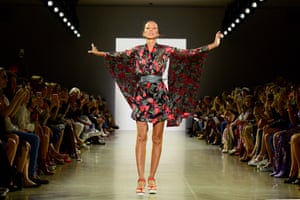
‘When the spotlight is on, you feel like you’re flying to the sun’ ... Cleveland walks for Nicole Miller at New York fashion week in September 2019. Photograph: Aurora Rose/Patrick McMullan/Getty Images
This energy has seen her through some extraordinary experiences. In March 2019, Cleveland was in Paris for fashion week when she fell ill with what was later diagnosed as colon cancer and taken to hospital. She was staying two floors down from where
Lagerfeld had died a month earlier. “I think I had a visitation by his ghost,” she says. “There he was, on the edge of my bed. He just said: ‘Don’t worry, my dear. You’re gonna be OK.’”
This proved true. A crowdfunding appeal set up by her husband to help pay her medical costs received donations from Jacobs, Posen, Helena Christensen and Katie Grand. “I didn’t know I had that many friends,” she says. “Thank God for Instagram!” That is how Cleveland stays in touch with her fashion people these days. “Because we love pictures. We like to keep it shiny and bright and we try to create that atmosphere of how we like the world to be. Now, even though there’s a whole bunch of stuff going on – and we understand it – designers and artists are put here to make the world beautiful.”
If you have only seen Cleveland on the catwalk, you might get the impression that she floats above the world’s troubles. But that is not quite right. As her Vogue vow – and her participation in a recent Black Trans Lives Matter event – shows, she has always been ready to oppose discrimination. But her gift is her connection to beauty. Like her peacocks, she is grounded – and fabulous.
The Guardian






